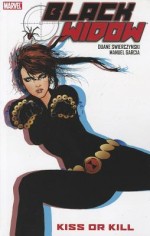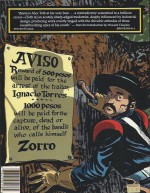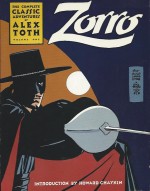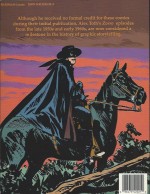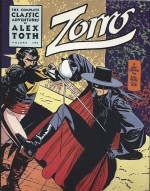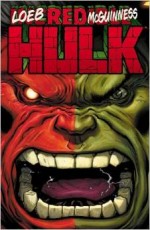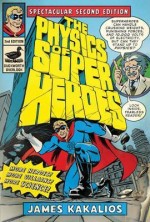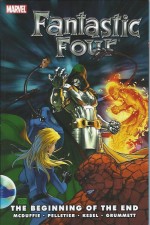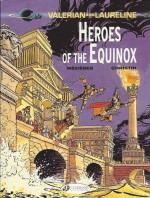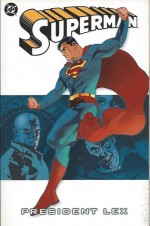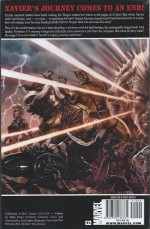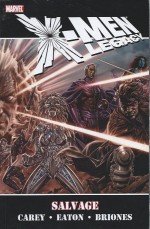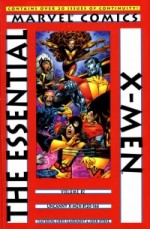
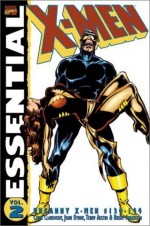
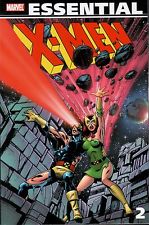
By Chris Claremont, John Byrne & Terry Austin, Brent Anderson & Joe Rubenstein (Marvel)
ISBN: 978-0-7851-0298-4
In 1963 TheX-Men #1 introduced Scott “Cyclops†Summers, Bobby “Iceman†Drake, Warren “Angel†Worthington, Jean “Marvel Girl†Grey and Hank “The Beast†McCoy: very special students of Professor Charles Xavier, a wheelchair-bound telepath dedicated to brokering peace and integration between the masses of humanity and the emergent off-shoot race of mutants dubbed Homo Superior. After years of eccentric and spectacular adventures the mutant misfits disappeared at the beginning of 1970 during a downturn in costumed hero comics whilst supernatural mysteries once more gripped the world’s entertainment fields.
Although the title was revived at the end of the year as a cheap reprint vehicle, the missing mutants were reduced to guest-stars and bit-players throughout the Marvel universe and the Beast was refashioned as a monster fit for the global uptick in scary stories until Len Wein & Dave Cockrum revived and reordered the Mutant mystique with a brand new team in Giant Size X-Men #1 in 1975.
To old foes-turned-friends Banshee and Sunfire was added one-shot Hulk hunter Wolverine, and all-original creations Kurt Wagner, a demonic German teleporter codenamed Nightcrawler, African weather “goddess†Ororo Monroe AKA Storm, Russian farmboy Peter Rasputin, who transformed at will into a living steel Colossus and bitter, disillusioned Apache superman John Proudstar who was cajoled into joining the makeshift squad as Thunderbird.
The revision was an instantaneous and unstoppable hit, with Wein’s editorial assistant Chris Claremont taking over the writing from the second story onwards. The X-Men reclaimed their own comicbook with #94 and it quickly became the company’s most popular – and high quality – title.
Cockrum was succeeded by John Byrne and as the team roster shifted and changed the series rose to even greater heights, culminating in the landmark “Dark Phoenix†storyline which saw the death of arguably the book’s most beloved and imaginative character.
In the aftermath team leader Cyclops left but the epic cosmic saga also seemed to fracture the epochal working relationship of Claremont and Byrne. Within months of publication they went their separate ways: Claremont staying with the mutants whilst Byrne moved on to establish his own reputation as a writer on series such as Alpha Flight, Incredible Hulk and especially his revolutionised Fantastic Four…
After Apache warrior Thunderbird became the team’s first fatality, the survivors slowly bonded, becoming an awesome fighting unit under the brusque and draconian supervision of Cyclops and this second superlative monochrome Essential collection re-presents the groundbreaking tales from (Uncanny) X-Men #120-144, covering April 1979 to April 1981.
The action begins here with the introduction of a foreign super-squad in ‘Wanted: Wolverine! Dead or Alive!’, as the enigmatic mutant, accompanied by Cyclops, Nightcrawler, Storm, Colossus, Banshee and Nightcrawler, return from a bombastic battle in Japan but are covertly herded into Canadian airspace so that the Ottawa government can confiscate their property.
Forced down by a magical tempest the heroes are soon on the run in Calgary, ambushed by the aforementioned Alpha Flight – specifically battle-armoured Vindicator, super-strong Sasquatch, magician Shaman, shapeshifting Snowbird and mutant speedster twins Northstar and Aurora – all ordered to repossess former special operative “The Wolverineâ€â€¦
After a brutal but inconclusive clash at the airport the X-Men fade into the city but only after Wolverine and Nightcrawler are captured…
The retaliation results in a ‘Shoot-Out at the Stampede!’ with the mutants confronting their pursuers as Shaman’s eldritch blizzard spirals out of control, threatening to destroy the entire province. Even after Storm fixes the problem, the Canadians are adamant and to end hostilities Wolverine surrenders himself in return for his comrades’ safe passage.
Of course he never promised to stay captured…
With Byrne producing light breakdowns, inker Terry Austin stepped up to produce full art finishes for issue #122’s ‘Cry for the Children!’ as the heroes finally return to the Xavier School to find their home boarded up and deserted.
Months previously, following a catastrophic battle against Magneto of which Beast and Phoenix believed themselves the only survivors, heartbroken Professor X had grieved for his fallen pupils and left Earth to be with his fiancée Empress Lilandra of the Shi’ar.
As the prodigals slowly settle in at the Professor’s mansion again, they try to resume their previous routines but psychological stress testing shows Russian Colossus is having second thoughts about deserting his family and country…
Reborn as the cosmic-powered Phoenix, Jean Grey went globetrotting to bury her woes and is currently in Scotland, unaware that she has been targeted by one of the team’s oldest enemies for a cruel assault. In New York, Storm has at last taken the time to trace her roots, visiting the old home of her American dad, only to find it now a junkie squat filled with doped and feral kids who viciously attack her…
Stabbed and bleeding she lashes out and only the sudden arrival of hero for hire Luke Cage and his friend Misty Knight (coincidentally Jean’s Manhattan room-mate) prevents a tragedy. None of them are remotely aware that they have been targeted by the world’s most outrageous hit-man…
With Byrne back in full pencil mode X-Men #123 includes a cameo from Spider-Man as jolly psycho-killer Arcade proceeds to pick off the oblivious mutants and run them through his fatal funfair Murder World in ‘Listen… Stop Me if You’ve Heard It… But This One Will Kill You!’, subjecting the abductees to perils mechanical and psychological.
The former prove understandably ineffectual but family guilt and cunning conditioning soon transform the homesick Russian into a vengeful mind-slave dubbed The Proletarian, determined to smash his former comrades in the concluding ‘He Only Laughs When I Hurt!’ Happily his inner child and the assorted heroes’ gifts and training prove too much for the maniacal killer clown…
Jean re-enters the picture when her stay with biologist Moira MacTaggert leads to the release of a long secret family shame in ‘There’s Something Awful on Muir Island!’ Throughout her long holiday Phoenix has been gradually turned and psychically seduced by a psionic predator. Groomed for a life of refined cruelty and debauchery by a man calling himself Jason Wyngarde, the intention is to create a callous “Black Queen†for the mysterious organisation known as the Hellfire Club…
At the other end of the galaxy Charles Xavier reviews records of how Phoenix once reconstructed the fragmenting universe and is gripped with terror at the thought of all that power in the hands of one frail human personality, whilst in his former home The Beast checks a tripped alarm and discovers his long-mourned friends are all alive.
The first thought is to tell Jean the incredible news, but no sooner is a transatlantic call connected than a scream echoes out and the line goes dead…
Issue #126 resumes frantic hours later as the X-Men approach Muir Island in their supersonic jet. With all contact lost and no telepath aboard, Cyclops assumes the worst and the team infiltrate in battle formation only to find a withered corpse and badly shaken comrades Lorna Dane, Havok, Madrox, Moira and Jean slowly recovering from a psionic assault.
In ‘How Sharper Than a Serpent’s Tooth…!’ Dr. MacTaggert bitterly reveals the attacker is a psychic bodysnatcher imprisoned on Muir for years. He’s also her son…
Rapidly burning out one of Madrox’s duplicate bodies, the monster has already reached the mainland, but as the mutants disperse to hunt him down Jean is hampered by a torrent of seductive mirages projected by the smugly confidant Wyngarde, allowing the predatory Proteus to ambush the X-Men and try to possess Wolverine.
It is his first mistake. Metal has an inimical effect on the formless horror and the feral fury’s Adamantium skeleton forces him to flee his victim in screaming agony. It is then the creature unleashes his most terrifying power: warping reality to drive Wolverine and Nightcrawler to the brink of madness. Only the late-arriving Storm prevents their immediate demise but soon she too is at the edge of destruction…
‘The Quality of Hatred!’ finds the badly shaken team undergoing desperate “tough-love†remedies from Cyclops to regain their combat readiness whilst Moira tries to make up for her dangerous sentimentality by putting a bullet into her deadly offspring.
Frustrated by the idealistic Cyclops but having divined the path Proteus is taking, she then heads for Edinburgh and an unpleasant reunion with her former husband: brute, bully, Member of Parliament and father of most merciless monster the world has yet produced…
As Jean finally shrugs off her distractions and telepathically homes in on Proteus, the team swing into action a little too late: the sinister son has possessed his scurrilous sire and created an unstoppable synthesis of world-warping abomination…
With Edinburgh and perhaps the entire world roiling and rebelling as science goes mad, X-Men #128 sees the valiant champions strike back and spectacularly triumph in ‘The Action of the Tiger!’ after which ‘God Spare the Child…’ sees another happy reunion as the heroes (all but the now retired Banshee) find Charles Xavier awaiting them when they reach Westchester.
Jean is increasingly slipping into visions of a former life as a spoiled, cruel child of privilege, contrasting sharply with her renewed love for Scott, but the home atmosphere is troubled by another discordant factor. Xavier is intent on resuming the training of the team, haughtily oblivious that this group are grizzled, seasoned veterans of combat, rather than the callow teenagers he first tutored.
Elsewhere a cabal of mutants and millionaires plot. Black King Sebastian Shaw, White Queen Emma Frost and the rest of the Hellfire Club hierarchy know Wyngarde is an ambitious and presumptuous upstart but the possibility of subverting the Phoenix to their world-dominating agenda is irresistible…
When two new mutants manifest Xavier splits the team to contact both, taking Storm, Wolverine and Colossus to Chicago to meet the parents of naive thirteen year old Kitty Pryde who has just realised that along with all the other problems of puberty she can now fall through floors and walk through walls…
However no sooner does Professor Xavier offer to admit her to his select and prestigious private school than they are all attacked by war-suited mercenaries and shipped by Emma Frost to the Hellfire Club. Only Kitty escapes, but instead of running she stows away on the transport; terrified but intent on saving the day…
The other mutant neophyte debuts in X-Men #130 as Cyclops, Phoenix and Nightcrawler head to Manhattan’s club district to track down a disco singer dubbed ‘Dazzler’ unaware that they too have been targeted for capture. However little Kitty’s attempts to free the captives at the Hellfire base forces the villains to tip their hand early and with the assistance of Dazzler Alison Blair – a musical mutant who converts sound to devastating light effects – the second mercenary capture team is defeated…
In #131 Kitty is frantically fleeing but her ‘Run for Your Life!’ leads straight into the arms of the remaining X-Men. Soon the plucky lass – after an understandable period of terror, confusion and kvetching – is leading an incursion into the lair of the White Queen and freeing Wolverine, Colossus and Xavier whilst Frost faces off for a psionic showdown with a Phoenix far less kind and caring than ever before…
The saga expands in #132 as ‘And Hellfire is their Name!’ brings the Angel back into the fold. The Hellfire Club is in actuality a centuries-old association of the world’s most powerful and wealthy individuals and Warren Worthington’s family have been members in good standing for generations. What better way of infiltrating the organisation than with someone on the inside?
As Wolverine and Nightcrawler scurry through sewers beneath the society’s palatial New York headquarters, Warren inveigles the rest through the grand front doors into the year’s swankiest soiree whilst he and the Professor await events.
It’s a bold move but a pointless one. Although the rank and file are simply spoiled rich folk, there is an Inner Circle led by Shaw which comprises some of Earth’s most dangerous men and women… and they have been waiting and watching for the mutants-in-mufti’s countermove…
As soon as the heroes are inside, Wyngarde strikes, pushing Jean until she succumbs to the fictitious persona he has woven to awaken her darkest desires. With her overwhelming power added to the Inner Circle’s might, former friends quickly fall before the attack of super-strong Shaw and cyborg human Donald Pierce. Even Wolverine is beaten, smashed through the floors to his doom by mass-manipulating mutant Harry Leland…
As the Inner Circle gloat, Cyclops – connected to Jean by their psionic rapport – sees the world through his lover’s corrupted, beguiled eyes and despairs. However, when Wyngarde, revealed as mutant illusion caster Mastermind, apparently stabs Cyclops the effect on “his†Black Queen is far from anticipated…
Far below their feet, a body stirs. Battered but unbowed ‘Wolverine: Alone!’ begins to work his ruthless, relentless way through the Club’s murderous minions. His explosive entrance in #134’s ‘Too Late, the Heroes!’ gives the heroes a chance to break free and strike back, soundly thrashing the Hellfire blackguards. Sadly for Mastermind, not all his tampering has been expunged and when Jean catches him Jason Wyngarde’s fate is ghastly beyond imagining…
As the mutants make their escape the situation escalates to crisis level as the mind-manipulation unleashes all Jean’s most selfish, self-serving desires and she shatteringly transforms into ‘Dark Phoenix’…
Manifested as a god without qualm or conscience, Jean attacks her comrades before vanishing into space. Soon she reaches a distant system and, cognizant that she is feeling depleted, consumes the star, indifferent to the entire civilisation that dies upon the planet circling it…
Passing the D’Bari system is a massive ship of the Shi’ar star fleet. Rushing to aid the already extinct world they are merely a postprandial palate cleanser for the voracious Phoenix…
X-Men #136 opens with the horrified Empress Lilandra mobilising her entire military machine and heading for Earth, determined to end the threat of the ‘Child of Light and Darkness!’ On that beleaguered world Cyclops has called in the Beast to build a psychic scrambler to disrupt Jean’s immeasurable psionic might but when she cataclysmically reappears to trounce the team, the device burns out in seconds.
Sporadically Jean’s gentler persona appears, begging her friends to kill her before she loses control, but Dark Phoenix is close to destroying the world before, in a cataclysmic mental duel, Xavier shuts down her powers and establishes psychic circuit breakers to prevent her ever going rogue again…
With Jean left as little more than human, the heroes shudder in the aftermath of Earth’s latest close call when suddenly in a flash of light they all vanish…
The epic tale concludes in X-Men #137 as the outraged and terrified Shi’ar arrive in orbit to settle ‘The Fate of the Phoenix!’ With observers from the Kree and Skrull empires in attendance, Lilandra has come to exact justice and prevent the Phoenix from ever rising again. She is not prepared to accept her fiancé’s word that the threat is already ended…
Summary execution is only avoided when Xavier invokes an ancient rite compelling Lilandra to accept a form of trial-by-combat. Relocating to the Blue Area of the Moon (with its pocket of breathable atmosphere) the mutants engage in all-out war with brigade of cosmic champions The Shi’ar Imperial Guard (an in-joke version of DC’s Legion of Super Heroes), but despite their greatest efforts are pushed to the brink of defeat.
With collapse imminent and her friends doomed, Jean’s psychic shackles slip and the Phoenix breaks free again. Horrified at what will inevitably happen, Jean commits suicide to save the universe…
Days later on Earth the X-Men mourn her passing in #138’s ‘Elegy’ as Cyclops recalls his life with the valiant woman he loved so deeply – and we get a comprehensive recap of the mutant team’s career to date. Heartbroken, the quintessential X-Man resigns just as Kitty Pryde moves in…
A new day dawns in issue #139 ‘…Something Wicked This Way Comes!’ as the Angel rejoins the squad in time to see Nightcrawler join Wolverine in heading north for a reconciliation with the Canadian’s previous team, Alpha Flight. The visit turns into a hunt for the carnivorous magical monster Wendigo, culminating in a brutal battle and a rare clean win in #140’s ‘Rage!’
X-Men #141 saw the start of an evocative and extended subplot which would dictate years of tales to come. ‘Days of Future Past’ depicted an imminently approaching dystopian apocalypse wherein almost all mutants, paranormals and superheroes have been eradicated by Federally-controlled Sentinel robots.
The mechanoids rule over a shattered world on the edge of utter annihilation. New York is a charnel pit with most surviving superhumans kept in concentration camps and only a precious few free to fight a losing war of resistance.
Middle-aged Kitty Pryde is the lynchpin of a desperate plan to unmake history. With the aid of telepath named Rachel (eventually to escape that time-line and become the new Phoenix) Pryde swaps consciousness with her younger self in a last-ditch attempt to prevent the pivotal event which created the bleak, black tomorrow where all her remaining friends and comrades are being pitilessly exterminated one by resolute one…
‘Mind Out of Time’ sees the mature Pryde in our era, inhabiting her juvenile body and leading her disbelieving team-mates on a frantic mission to foil the assassination of US senator David Kelly on prime-time TV by a sinister new iteration of the Brotherhood of Evil Mutants – super-powered terrorists determined to make a very public example of the human politician attacking the cause of Mutant Rights…
Fast-paced, action-packed, spectacularly multi-layered, bitterly tragic and tensely inconclusive – as all such time-travel tales should be – this cunning, compact yarn is indubitably one of the best individual tales of the Claremont/Byrne era and set the mood, tone and agenda for the next two decades of mutant mayhem…
With history restored and tragedy averted things slowed down at the X-Mansion as John Byrne left for pastures new. His swan song in #143 was a bombastic romp which found lonely, homesick Kitty home alone at Christmas… except for a lone N’garai ‘Demon’ determined to eat her…
Her solo trial decimated the X-Men citadel and proved once and for all that she had what it takes…
The story portion of this classic compendium concludes with ‘Even in Death…’ from X-Men #144, scripted by Claremont and illustrated by Brent Anderson & Joseph Rubenstein wherein heartbroken Scott fetches up in coastal village Shark Bay and joins the crew of Aleytys Forester‘s fishing boat.
Trouble is never far from the man called Cyclops however and when she introduces him to her dad the hero must draw upon all his inner reserves – and uncomprehending help of the macabre Man-Thing – to repel the crushing soul-consuming assaults of pernicious petty devil D’spayre…
Accompanied by fact-filled entries on Professor X, Cyclops, Wolverine, Colossus, Nightcrawler, Beast and Angel, all taken from the Marvel Universe Handbook, this comprehensive monochrome includes some of the greatest stories Marvel ever published; entertaining, groundbreaking and painfully intoxicating. These adventures are an invaluable grounding in contemporary fights ‘n’ tights fiction no fan or casual reader can afford to ignore.
© 1979, 1980, 1981, 1997, 2007 Marvel Characters, Inc. All rights reserved.


